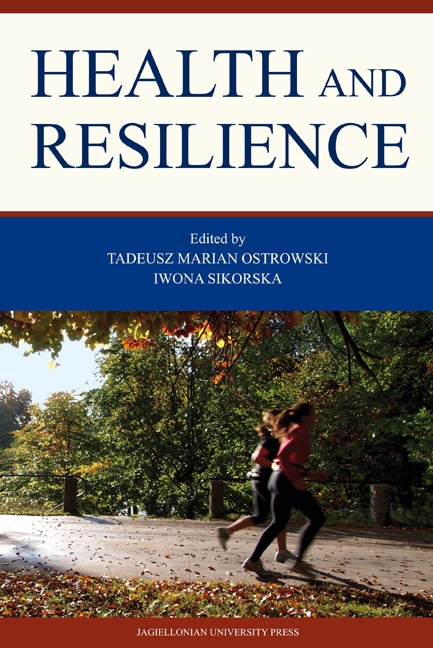Book contents
- Frontmatter
- TABLE OF CONTENTS
- Introduction
- I SOCIAL AND METHODOLOGICAL CONTECTS OF RESILIENCE
- II RESILIENCE IN DEVELOPMENT
- III RESILIENCE AND DISEASE
- Resilience as a chance of developmental success for a child with a chronic illness
- Coping with stress amongst families with children suffering from chronic psychosomatic diseases – recommendations for psychoprophylactic actions
- Styles of coping with negative emotions and stress in patients with hypertension
- Family life dimensions and self-assessment of adolescents and young adults using psychoactive substances – the comparative studies
- List of Authors
Family life dimensions and self-assessment of adolescents and young adults using psychoactive substances – the comparative studies
from III - RESILIENCE AND DISEASE
Published online by Cambridge University Press: 05 December 2014
- Frontmatter
- TABLE OF CONTENTS
- Introduction
- I SOCIAL AND METHODOLOGICAL CONTECTS OF RESILIENCE
- II RESILIENCE IN DEVELOPMENT
- III RESILIENCE AND DISEASE
- Resilience as a chance of developmental success for a child with a chronic illness
- Coping with stress amongst families with children suffering from chronic psychosomatic diseases – recommendations for psychoprophylactic actions
- Styles of coping with negative emotions and stress in patients with hypertension
- Family life dimensions and self-assessment of adolescents and young adults using psychoactive substances – the comparative studies
- List of Authors
Summary
Abstract
This article, the theoretic principles of which have been based on the concept of protective factors of J.D. Hawkins' and Circle Model of D.H. Olson, considers the problem of relation between family life dimensions and bonds in family systems and using psychoactive substances by adolescents and young adults. The experimental group consisted of 32 individuals between the ages of 17 to 25 who have used psychoactive substances and the control group consisted of 34 years randomly chosen group at the comparable ages. The objection of the studies have been, among other things, to verify the hypotheses suggesting the relation between negative experience of communication and bonds in family (family functioning worse in dimension of cohesion and flexibility) and using psychoactive substances.
In the studies have been used: the biographic questionnaire developed by the authors of the article, Family Relationships Questionnaire (FRQ) by Mieczysław Plopa, Family Assessment Scale (FAS) and Multiple Self-Assessment Questionnaire MSEI by O'Brein and Epstein. The results of the analysis prove conclusively that individuals from experimental group receive lower outcomes in the following dimensions of their families functioning: cohesion, flexibility, rigidity, while higher ones described as lack of bonding. No statistically significant or direct relation has been proved between the quality of communication and using the psychoactive substances.
Key words: self-assessment, context of using psychoactive substances, family life
Introduction
The characteristic of communication process in perspective of current theoretic conclusions
The notion of communication belongs to arising controversy issues.
- Type
- Chapter
- Information
- Health and Resilience , pp. 193 - 210Publisher: Jagiellonian University PressPrint publication year: 2014

